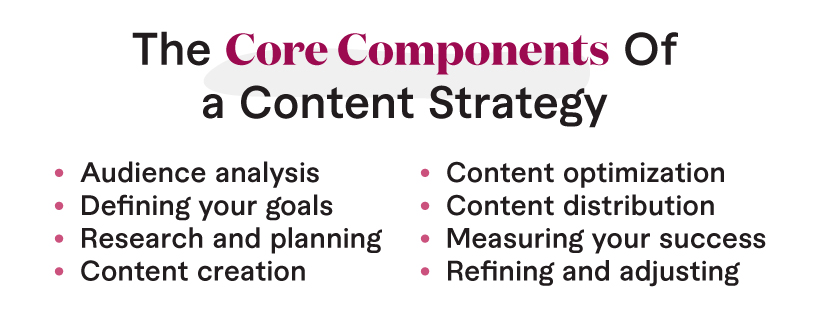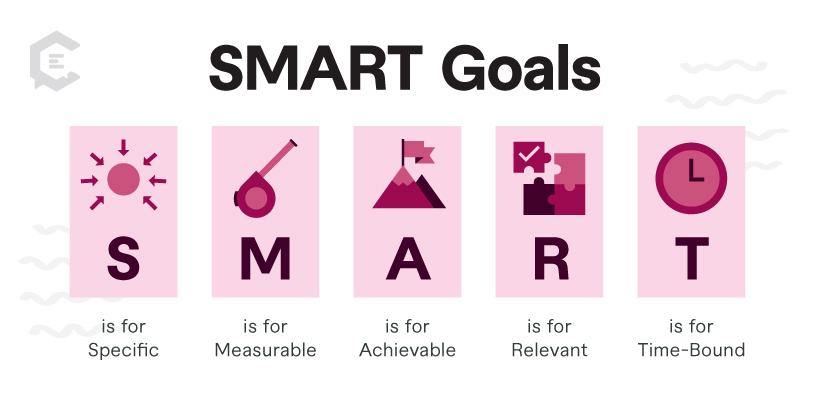
What is a Content Strategy?
A content strategy is the process of planning, creating, delivering, and maintaining content to align with business goals. It’s not just the what. It’s also the how, why, when, and where.
Content strategy requires understanding the needs and behaviors of the target audience. The easiest way to do that is by first identifying key performance indicators (KPIs) and goals. Then, determine what types of content will be most effective in achieving them. Some examples of goals for a content strategy would be:
- Increasing brand awareness
- Driving more traffic
- Increasing leads
- Increasing conversions
- Building brand loyalty
- Retaining customers
- Higher brand visibility
In addition, a content strategy involves creating a plan for regularly producing and promoting the content you create.
The strategy may also include guidelines for how you will govern, update, and evaluate your content. Creating a content matrix to categorize content by customer journey and segments can also be helpful.
A well-crafted content strategy helps ensure the content aligns with business objectives, user needs, and organizational resources.
The core components of a content strategy include:
- Audience analysis
- Defining your goals
- Research and planning
- Content creation
- Content optimization
- Content distribution
- Measuring your success
- Refining and adjusting
If you’re unsure where to start, check out our guide to elevating your content strategy.
Why Having a Content Strategy is Important
You wouldn’t drive cross-country without a map. Nor should you create content without a strategy.
97 percent of marketers reported using content marketing as part of their overall marketing strategy. But, only 57 percent reported having a documented strategy. And only 19 percent considered their strategy “advanced.”
That means most businesses are using content marketing but not unlocking its full potential.
Without a solid strategy, your content marketing efforts will be like throwing spaghetti at the wall and seeing what sticks. Haphazard content marketing leads to haphazard results (if any at all).
A content strategy aligns all your team members, workflows, and technology and gets them moving in the same direction.
Breaking Down the Core Components
Audience analysis
It all begins with understanding your audience. Before you begin any content creation, you have to pinpoint who it’s for. Here, analytics are your best friend. Tools like Google Analytics can give you an overview of who’s already engaging with your brand. In order you build your buyer personas, start with demographics like:
- Age
- Occupation
- Gender
- Education
- Location
Then, dive deeper into your audience’s psychographics:
- Values
- Opinions
- Attitudes
- Interests
Ultimately, you’re gathering all this data to answer two questions:
- Who is your audience?
- What drives them to take action?
Then, you can start to build goals around meeting their needs and pain points.
Defining your goals
A content strategy without clear goals is dead in the water. Your goals ensure all your efforts are headed in the same direction. The beauty of content marketing is in its versatility. You can tailor it depending on your brand’s specific needs. We mentioned some goals earlier. Most content strategy goals revolve around four areas:
- Brand awareness
- Thought leadership
- Lead generation
- Engagement and loyalty
Creating SMART goals
Use the SMART framework to make sure your goals are concrete instead of vague. SMART stands for:
- Specific
- Measurable
- Achievable
- Relevant
- Time-bound
Using that structure will ensure your goals are clear and well-crafted. It’ll also inform how you plan and research your content creation.
Research and planning
It’s finally time to start building your content roadmap. As you go through this, keep in mind that this will likely evolve as your business does. The important thing is having a plan you can refer back to you. Follow this five-step process:
Conduct content research
Start by examining your existing content (if you have some). Make a list that analyzes strengths and weaknesses. Note which pieces are doing well and which aren’t. Use your key performance indicators to identify where the gaps are. Rework or eliminate content that doesn’t match your newly defined goals. That should give you a clear picture of your current content situation.
Create a keyword and topic portfolio
Next up is your keyword strategy. Build a list of strong keywords relevant to your business that will likely attract organic traffic. Once you brainstorm a list, use a tool like Google AdWords Keyword Planner to research the monthly search volume of each keyword. You’ll notice some keywords are highly competitive while others are easier to rank for. Strike a balance and pick keywords with good traffic volume but aren’t the most competitive.
Topic ideation and prioritization
Now, it’s time to think about topics. Use each keyword as a starting point to brainstorm potential topics around. Each topic should also generate a list of relevant subtopics for more niche content creation.
A great way to generate ideas is to type your keyword or topic idea into Google and see the most popular related questions. Or, you can use tools like ChatGPT to ideate large topic lists quickly that you can pull from.
Once you have your topics, it’s time to think about which ones you’ll create first.
Taxonomies
You might be wondering what a taxonomy even is. We’ll make it simple. It’s a classification system for organizing content. Think of it like a hierarchy. The top of your taxonomy chart will begin with your broadest, most-search for topics. Each of those will generate multiple subtopics, and so on.
A good technique is to organize your content around themes instead of keywords. Or you can use a pillar content strategy where one piece of content covers a topic comprehensively, and then you create “cluster” pieces that branch off into subtopics.
Having a strong taxonomy structure in place ensures Google knows how to rank the importance of your pages and which ones to give more authority to.
Content briefs
We’re at the last step! The final piece of the puzzle is to create a content brief. Content briefs keep everyone on the same page about what’s being created and why. They also organize tracking your content’s progress and making sure it’s meeting your goals.
Templates work great here. An example would be this:
- Main deliverables
- Word count
- Suggested titles
- Target audience
- Suggested keywords
- Goal of the piece
- Key takeaways
- Questions to answer
- An outline (optional)
- Suggested resources
- Internal linking
- Any additional details
And with that, it’s finally time to create.
Content creation and optimization
Creating high-quality, compelling content is one of the most important aspects of your content strategy. Great content helps generate organic traffic, turn users into leads, and convert those leads into paying customers.
Creating high-quality, engaging content
To ensure your content is as good as it can be, ask yourself these seven questions:
- Is it providing value?
- Is it engaging and well-structured?
- Is it clear and actionable?
- Is it proofread and polished?
- Is it upfront and honest?
- Is it updated?
- Does it align with your business goals?
If your content hits all those checkmarks, you can move on to optimizing it.
Optimizing for SEO and User experience
It doesn’t matter how high the quality of your content if no one can see it. Even more so if it’s also hard to digest. A robust content optimization process ensures two things:
- Your content has a strong and seamless user experience
- Your content is optimized for SEO
Both work together to make your content highly visible and engaging. Incorporate best SEO practices, user experience guidelines, and AI tools to streamline your optimization process while maximizing its effect.
Content distribution and promotion
Alright, you’ve created amazing, high-quality content that couldn’t be any more optimized. Now, we have to make sure it actually reaches your target audience! So, let’s get it out there.
Your previous audience research will inform how and where you distribute your content. Where is your audience hanging out? Are most of them reading your blog? Are more of them on one of the social media platforms? Or, maybe your best engagement is through your email list.
Developing a detailed content distribution plan will ensure you’re setting your content up for success.
Measuring your success and refining
Alright, you’ve hit publish and now you’re done! Except… you’re not.
Remember when we talked about identifying KPIs? It’s time to use them. They’ll help you understand where your content is succeeding and where it needs improvement. Some of the most common metrics to monitor are:
- Conversion rate
- Website traffic
- Click-through rate
- Bounce rate
- Churn rate
- Time on page
- Page views
- Unique visitors
The information you gather from these metrics will inform you next steps. From there, you can make adjustments to your content creation. You can shore up the gaps where needed and double down on the parts of your strategy that are working. It’s a continuous process. So, make sure you have regular content audits and reviews in place.
Next Steps to Elevating Your Content Strategy
This guide is designed to give you a basic framework. But the work doesn’t stop there. Recalibrating and refining your content strategy is a never-ending process, which makes sense. As technology and user behaviors evolve and change, so should your strategy.
That being said, partnering with a proven content agency could be a better and more cost-effective solution for your brand. At ClearVoice, our expert strategists and content teams can help you craft a top-tier content strategy that drives your brand’s growth and success.
Discover our solutions or connect with a strategist today to see how we can take you to the next










